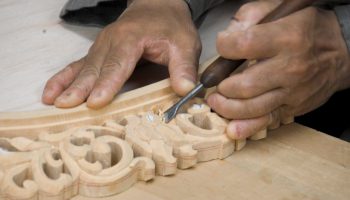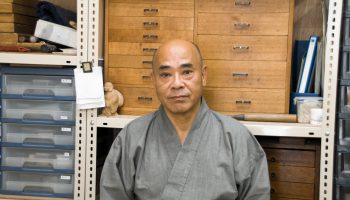Edo Moku-Chokoku [ Wood Carring ]
Yokoya Mitsuaki

Mitsuaki Yokoya is the third generation of Soshu, a workshop of Edo wood sculpture. After 10 years of training, at the age of 25 he started working under his father. In 1993, the second generation transferred the workshop to the current location, after the war (vanished due to an air raid). He said that although there were many sculptors in the era of the second generation, it gradually decreased, and currently Soshu is the only wood sculpture store in Tokyo.
While the shortage of craftsmen is a serious issue, many people admired to become sculpture craftsman, but it seems that many people do not continue long enough, because even if they actually start the work toward, it takes time to be able to stand on their own as a sculptor.
In Soshu, making architectural sculptures for shrines or temples are the main work, at request from designers, carpenters or building companies specializing in building shrines and temples, he is handling the work for pillars, ranma (a wooden panel with openwork carving used as a decorative transom above the sliding partitions between two rooms) throughout the country. In addition, he also makes western style sculptures to be applied to frame of temple or shrine name plate, frame of company name, Buddhist image of Buddhist altar, carving on altars, ornament, chair, table, etc.
In wooden sculpture work, first you imagine the work you want to make and draw the picture on a paper. For example, in the case of making temple or shrine sculpture, we cut the paper pattern and pressed it on wood, and we proceed carving in the order of wood cutting, rough carving, detailed carving, and finishing. When coloring is needed, then the next step is coloring.
There are lots of carving techniques, such as round carving, watermark carving, embossed carving, texture carving, thick carvings, etc., and these techniques are combined according to the image you want to make, in order to create a beautiful wood carvings. Woods such as Japanese cypress, Japanese zelkova, Yellow cedar which has strong durability are used for architectural sculpture, and woods such as camphor, Japanese zelkova, Japanese cherry, Chinese scholar, Japanese cypress, boxwood and sandalwood are used for ornaments.
“Wood sculpture can be inherited for a long time is a merit, and it is grateful as a sculptor if one can inherit it forever,” says Mr. Yokoya.




